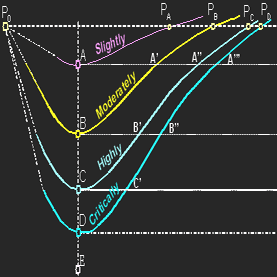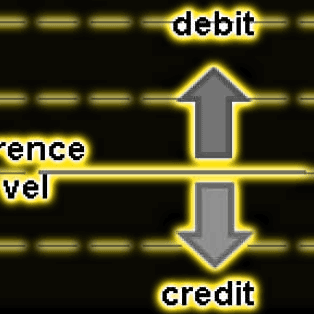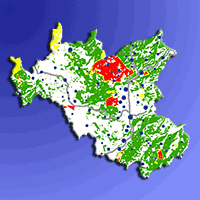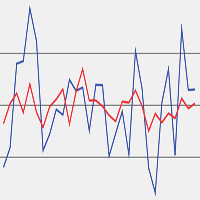Deforestation in the tropical developing countries is the critical environmental concern to ecologists and environmentalists. Environmental Kuznets Curve (EKC) hypothesis is critical to understanding the development path of a nation in relevance to its environment. The dictation of national economic growth to deforestation can be found through the study of EKC. To understand the EKC phenomena for deforestation, the study was undertaken through reviewing the literature. With the understanding of the different EKC trajectories for deforestation, an attempt was made to implicate the economic development of Bangladesh with the EKC. The proven EKC trajectories for deforestation in some regions/countries show a higher income per capita requirement for the turning point. The study suggests that tunneling in the EKC trajectory for Bangladesh would be favorable. The type of economic and forest policy that Bangladesh should follow to retard deforestation is also revealed. Clean Development Mechanism (CDM) and Reducing Emissions from Deforestation and forest Degradation (REDD) have been suggested for tunneling the EKC in Bangladesh. The findings of the study are expected to contribute to the environmental development of Bangladesh.
Keywords
, , , , ,
Citation
Miah MD, Masum MFH, Koike M, Akther S (2011). A review of the environmental Kuznets curve hypothesis for deforestation policy in Bangladesh. iForest 4: 16-24. - doi: 10.3832/ifor0558-004
Paper history
Received: Aug 13, 2010
Accepted: Dec 13, 2010
First online: Jan 27, 2011
Publication Date: Jan 27, 2011
Publication Time: 1.50 months
© SISEF - The Italian Society of Silviculture and Forest Ecology 2011
Open Access
This article is distributed under the terms of the Creative Commons Attribution-Non Commercial 4.0 International (https://creativecommons.org/licenses/by-nc/4.0/), which permits unrestricted use, distribution, and reproduction in any medium, provided you give appropriate credit to the original author(s) and the source, provide a link to the Creative Commons license, and indicate if changes were made.

Breakdown by View Type
(Waiting for server response...)
Article Usage
Total Article Views: 78080
(from publication date up to now)
Breakdown by View Type
HTML Page Views: 66184
Abstract Page Views: 3579
PDF Downloads: 6182
Citation/Reference Downloads: 89
XML Downloads: 2046
Web Metrics
Days since publication: 5436
Overall contacts: 78080
Avg. contacts per week: 100.54
Article Citations
Article citations are based on data periodically collected from the Clarivate Web of Science web site
(last update: Mar 2025)
Total number of cites (since 2011): 8
Average cites per year: 0.53
Publication Metrics
by Dimensions ©
Articles citing this article
List of the papers citing this article based on CrossRef Cited-by.
(1)
ADB (2009)Bangladesh quarterly economic update. Bangladesh Resident Mission, Asian Development Bank, Dhaka, Bangladesh.
Gscholar
(2)
Alam M, Sathaye J, Barnes D (1998)Urban household energy use in India: efficiency and policy implications. Energy Policy 26 (11): 885-891.
CrossRef |
Gscholar
(3)
Balat M, Ayar G (2005)Biomass energy in the world, use of biomass and potential trends. Energy Sources, Part A: Recovery, Utilization, and Environmental Effects 27 (10): 931-940.
CrossRef |
Gscholar
(4)
Barbier EB, Burgess JC (2001)The economics of tropical deforestation. Journal of Economic Surveys 15 (3): 413-433.
CrossRef |
Gscholar
(5)
Barbier EB, Burgess JC, Grainger A (2010)The forest transition: Towards a more comprehensive theoretical framework. Land Use Policy 27 (2): 98-107.
CrossRef |
Gscholar
(6)
BBS (2009)Statistical year book of Bangladesh. Bangladesh Bureau of Statistics, Ministry of Planning, Government of the People’s Republic of Bangladesh, Dhaka, Bangladesh.
Gscholar
(7)
Bhattarai M, Hammig M (2001)Institutions and the environmental Kuznets curve for deforestation: a cross-country analysis for Latin America, Africa and Asia. World Development 29 (6): 995-1010.
CrossRef |
Gscholar
(8)
Brown LR (2006)Plan B 2.0: Rescuing a planet under stress and a civilization in trouble. Earth Policy Institute, New York, USA.
Gscholar
(9)
Carlson KM, Curran LM (2009)REDD pilot project scenarios: are costs and benefits altered by spatial scale? Environmental Research Letters 4: 1-3.
CrossRef |
Gscholar
(10)
Chowdhury MSH, Koike M, Muhammed N (2009)Embracing collaborative protected area management for conservation: an analysis of the development of the forest policy of Bangladesh. International Forestry Review 11 (3): 359-374.
CrossRef |
Gscholar
(11)
Chun YW (2002)Forest and People. Seoul, South Korea.
Gscholar
(12)
CIA (2008)The World Factbook.
Gscholar
(13)
Cohen B (2001)Urbanization in developing countries: Current trends, future projections, and key challenges for sustainability. Technology in Society 28 (1-2): 63-80.
CrossRef |
Gscholar
(14)
Culas RJ (2007)Deforestation and the environmental Kuznets curve: An institutional perspective. Ecological Economics 61: 429-437.
CrossRef |
Gscholar
(15)
Davis M (1998)Rural household energy consumption: the effects of access to electricity-evidence from South Africa. Energy Policy 26 (3): 207-217.
CrossRef |
Gscholar
(16)
DeFries R, Pandey D (2010)Urbanization, the energy ladder and forest transitions in India’s emerging economy. Land Use Policy 27 (2): 130-138.
CrossRef |
Gscholar
(17)
DeFries RS, Rudel T, Uriarte M, Hansen M (2010)Deforestation driven by urban population growth and agricultural trade in the twenty-first century. Nature Geoscience 3 (3): 178-181.
CrossRef |
Gscholar
(18)
DESA (2010)World urbanization prospects: the 2009 revision. ESA/P/WP/215, Department of Economic and Social Affairs, United Nations Secretariat, United Nations, New York, USA.
Gscholar
(19)
Ehrhardt-Martinez K, Crenshaw EM, Jenkins JC (2002)Deforestation and the environmental Kuznets curve: A cross-national investigation of intervening mechanisms. Social Science Quarterly 83 (1): 226-243.
CrossRef |
Gscholar
(20)
Ewers RM (2006)Interaction effects between economic development and forest cover determine deforestation rates. Global Environmental Change 16 (2): 161-169.
CrossRef |
Gscholar
(21)
FAO (1998)Asia-pacific forestry sector outlook study: country report - Bangladesh. APFSOS/ WP/48 edn., FAO Regional Office for Asia and the Pacific, Bangkok, Thailand.
Gscholar
(22)
FAO (2007)State of the world’s forests 2007. Food and Agriculture Organization (FAO), The United Nations, Rome, Italy.
Gscholar
(23)
Fearnside PM, Laurance WF (2004)Tropical deforestation and greenhouse-gas emissions. Ecological Applications 14 (4): 982-986.
CrossRef |
Gscholar
(24)
Gangadharan L, Valenzuela MR (2001)Interrelationships between income, health and the environment: extending the environmental Kuznets curve hypothesis. Ecological Economics 36 513-531.
CrossRef |
Gscholar
(25)
GOB (2000a)Economic survey of Bangladesh. Ministry of Finance, The Peoples’ Republic of Bangladesh, Dhaka, Bangladesh.
Gscholar
(26)
GOB (2000b)Economic survey of Bangladesh. Ministry of Finance, The Peoples’ Republic of Bangladesh, Dhaka, Bangladesh.
Gscholar
(27)
GOB (2008)Renewable energy policy of Bangladesh. Power division, Ministry of Power, Energy and Mineral Resources, Government of the People’s Republic of Bangladesh, Dhaka, Bangladesh.
Gscholar
(28)
Grossman GM, Krueger AB (1991)Environmental impacts of a north American free trade agreement. NBER Working Papers Series No. 3914, National Bureau of Economic Research, Cambridge, UK.
Gscholar
(29)
Grossman GM, Krueger AB (1995)Economic growth and the environment. Quarterly Journal of Economics 110 (2): 353-377.
CrossRef |
Gscholar
(30)
Gupta G, Köhlin G (2006)Preferences for domestic fuel: Analysis with socio-economic factors and rankings in Kolkata, India. Ecological Economics 57: 107-121.
CrossRef |
Gscholar
(31)
Heltberg R (2004)Fuel switching: evidence from eight developing countries. Energy Economics 26 (5): 869-887.
CrossRef |
Gscholar
(32)
Iftekhar MS (2006)Forestry in Bangladesh: An overview. Journal of Forestry 104 (3): 148-153.
Gscholar
(33)
IPCC (2007)Climate change 2007: synthesis report. Cambridge University Press, Cambridge, UK and New York, USA.
Gscholar
(34)
IUCN (2000)Red list of threatened animals of Bangladesh. International Union for Conservation of Nature (IUCN), Dhaka, Bangladesh.
Gscholar
(35)
Joon V, Chandra A, Bhattacharya M (2009)Household energy consumption pattern and socio-cultural dimensions associated with it: A case study of rural Haryana, India. Biomass and Bioenergy 33 (11): 1509-1512.
CrossRef |
Gscholar
(36)
KFS (2006)Forest distribution: Republic of Korea. Korea Forest Service (KFS), web site.
Gscholar
(37)
Khan MS, Rahman MM, Ali MA (2001)Red Data book of vascular plants of Bangladesh. Bangladesh National Herbarium, Dhaka, Bangladesh.
Gscholar
(38)
Khatun K, Valdes PJ, Knorr W, Chaturvedi RK (2010)Assessing the mitigation potential of forestry activities in a changing climate: A case study for Karnataka. Forest Policy and Economics 12 (4): 277-286.
CrossRef |
Gscholar
(39)
Klooster D, Masera O (2000)Community forest management in Mexico: carbon mitigation and biodiversity conservation through rural development. Global Environmental Change-Human and Policy Dimensions 10 (4): 259-272.
CrossRef |
Gscholar
(40)
Koop G, Tole L (1999)Is there an environmental Kuznets curve for deforestation? Journal of Development Economics 58 (1): 231-244.
CrossRef |
Gscholar
(41)
Koop G, Tole L (2001)Deforestation, distribution and development. Global Environmental Change-Human and Policy Dimensions 11 (3): 193-202.
CrossRef |
Gscholar
(42)
Kuznets S (1955)Economic growth and income inequality. The American Economic Review 45 (1): 1-28.
Gscholar
(43)
Lambin EF, Meyfroidt P (2010)Land use transitions: Socio-ecological feedback versus socio- economic change. Land Use Policy 27 (2): 108-118.
CrossRef |
Gscholar
(44)
Laurance WF (2007)Forest destruction in tropical Asia. Current Science 93 (11): 1544-1550.
Gscholar
(45)
Leach MC (1992)The energy transition. Energy Policy 20 (2): 116-123.
CrossRef |
Gscholar
(46)
Lush L, Cleland J, Lee K, Walt G (2000)Politics and fertility: a new approach to population policy analysis. Population Research and Policy Review 19 (1): 1-28.
CrossRef |
Gscholar
(47)
Mather AS (2007)Recent Asian forest transitions in relation to forest-transition theory. International Forestry Review 9 (1): 491-502.
CrossRef |
Gscholar
(48)
Melick D (2010)Credibility of REDD and experiences from Papua New Guinea. Conservation Biology 24 (2): 359-361.
CrossRef |
Gscholar
(49)
Meyfroidt P, Lambin EF (2008)The causes of the reforestation in Vietnam. Land Use Policy 25 (2): 182-197.
CrossRef |
Gscholar
(50)
MoEF (2005)National Adaptation Programme of Action (NAPA). UNDP and MoEF, Government of the People’s Republic of Bangladesh, Dhaka, Bangladesh.
Gscholar
(51)
MoEF (2008)Bangladesh climate change strategy and action plan 2008. Ministry of Environment and Forests, Government of teh People’s Republic of Bangladesh, Dhaka, Bangladesh, pp. xvi + 68.
Gscholar
(52)
Muhammed N, Koike M, Haque F (2008)Forest policy and sustainable forest management in Bangladesh: an analysis from national and international perspectives. New Forests 36 (2): 201-216.
CrossRef |
Gscholar
(53)
Munasinghe M (1995)Making economic growth more sustainable. Ecological Economics 15 (2): 121-124.
CrossRef |
Gscholar
(54)
Munasinghe M (1999)Is environmental degration an inevitable consequence of economic growth: tunneling through the environmental Kuznets curve. Ecological Economics 29: 89-109.
CrossRef |
Gscholar
(55)
Niroula GS, Thapa GB (2005)Impacts and causes of land fragmentation, and lessons learned from land consolidation in South Asia. Land Use Policy 2 2(4): 358-372.
CrossRef |
Gscholar
(56)
Oestreicher JS, Benessaiah K, Ruiz-Jaen MC, SloanS, Turner K, Pelletier J, Guay B, Clark KE, Roche DG, Meiners M, Potvin C (2009)Avoiding deforestation in Panamanian protected areas: an analysis of protection effectiveness and implications for reducing emissions from deforestation and forest degradation. Global Environmental Change-Human and Policy Dimensions 19 (2): 279-291.
CrossRef |
Gscholar
(57)
Ravindranath NH, Balachandra P, Dasappa S, Usha Rao K (2006)Bioenergy technologies for carbon abatement. Biomass and Bioenergy 30 (10): 826-837.
CrossRef |
Gscholar
(58)
Reddy BS, Balachandra P (2006)Dynamics of technology shifts in the household sector-implications for clean development mechanism. Energy Policy 34 (16): 2586-2599.
CrossRef |
Gscholar
(59)
Rudel TK, Coomes OT, Moran E, Achard F, Angelsen A, Xu J, Lambin E (2005)Forest transitions: towards a global understanding of land use change. Global Environmental Change Part A 15 (1): 23-31.
CrossRef |
Gscholar
(60)
Rudel TK, Schneider L, Uriarte M (2010)Forest transitions: an introduction. Land Use Policy 27 (2): 95-97.
CrossRef |
Gscholar
(61)
Salam MA, Noguchi T, Koike M (1999)The causes of forest cover loss in the hill forests in Bangladesh. Geojournal 47 (4): 539-549.
CrossRef |
Gscholar
(62)
Santilli M, Moutinho P, Schwartzman S, Nepstad D, Curran L, Nobre C (2005)Tropical deforestation and the Kyoto Protocol. Climatic Change 71: 267-276.
CrossRef |
Gscholar
(63)
Scrieciu SS (2007)Can economic causes of tropical deforestation be identified at a global level? Ecological Economics 62: 603-612.
CrossRef |
Gscholar
(64)
Selden TM, Song D (1994)Environmental quality and development: is there a Kuznets curve for air pollution emissions? Journal of Environmental Economics and Management 27 (2): 147-162.
CrossRef |
Gscholar
(65)
Selden TM, Song D (1995)Neoclassical growth, the J curve for abatement, and the inverted U curve for pollution. Journal of Environmental Economics and Management 29 (2): 162-168.
CrossRef |
Gscholar
(66)
Shafik N (1994)Economic development and environmental quality: an econometric analysis. Oxford Economic Papers 46: 757-773.
Gscholar
(67)
Shafik N, Bandyopadhyay S (1992)Economic growth and environmental quality: time series and cross-country evidence. Background paper for the World Development Report 1992, The World Bank.
Gscholar
(68)
Shin MY, Miah MD, Lee KH (2008)Mitigation options for the Bangladesh forestry sector: implications of the CDM. Climate Policy 8 (3): 243-260.
CrossRef |
Gscholar
(69)
Silveira S (2005)Promoting bioenergy through the clean development mechanism. Biomass and Bioenergy 28 (2): 107-117.
CrossRef |
Gscholar
(70)
Singh PP (2008)Exploring biodiversity and climate change benefits of community-based forest management. Global Environmental Change 18 (3): 468-478.
CrossRef |
Gscholar
(71)
Skutsch M, Trines E (2008)Policy piece: report from the UNFCCC meeting in Bali. African Journal of Ecology 71: 267-276.
Gscholar
(72)
Stern DI (2004)The rise and fall of the environmental Kuznets curve. World Development 32 (8): 1419-1439.
CrossRef |
Gscholar
(73)
Stickler CM, Nepstad DC, Coe MT, et al. (2009)The potential ecological costs and cobenefits of REDD: a critical review and case study from the Amazon region. Global Change Biology 15 (12): 2803-2824.
CrossRef |
Gscholar
(74)
Teixeira MA, Murray ML, Carvalho MG (2006)Assessment of land use and land use change and forestry (LULUCF) as CDM projects in Brazil. Ecological Economics 60 (1): 260-270.
CrossRef |
Gscholar
(75)
Torras M, Boyce JK (1998)Income, inequality, and pollution: a reassessment of the environmental Kuznets curve. Ecological Economics 25: 147-160.
CrossRef |
Gscholar
(76)
Trivedi MR, A W Mitchell AW, Mardas N, Parker C, Watson JE, Nobre AD, et al. (2009)REDD and PINC: A new policy framework to fund tropical forests as global “eco-utilities”. IOP Conference Series: Earth and Environmental Science 8 (1): 012005.
CrossRef |
Gscholar
(77)
UNFCCC (2007)Views on issues related to further steps under the convention related to reducing emissions from deforestation in developing countries: approaches to stimulate action. Subsidiary Body for Scientific and Technological Advice (SBSTA), United National Framework Conventions on Climate Change (UNFCCC).
Gscholar
(78)
USCB (2009)International Data Base (IDB): Population Division. Population Studies Branch, International Programs Center, Washington, DC, USA.
Gscholar
(79)
Winslow M (2005)The environmental Kuznets curve revisited once again. Forum for Social Economics 35 (1): 1-18.
CrossRef |
Gscholar


















